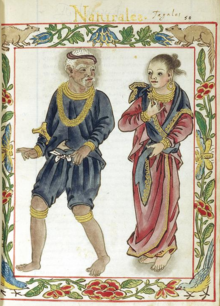Timawa
Timawa were called members of the pre-colonial feudal Tagalog society on the island of Luzon , Philippines . They had the same rights and duties as the class of Maharlika , which was below them, and formed the second class in the social system of the pre-colonial Tagalog society. They were free followers of a Datus, Rajah or Lakan. From today's perspective, the Timawas class was equivalent to the European noble landlords of the early Middle Ages.
They were free common members of society and did not have to pay tribute to the aristocratic Maginoo class . The Timawa owned their own land and could voluntarily, from time to time, cultivate the fields of the aristocratic Datus or otherwise make themselves useful in the community. They were free to change tribe or leader. In the hierarchically structured society, the Timawas stood above the Maharlikas and the unfree Alipin ; the latter represented the social basis. In contrast to comparable European societies, however, the social model of the Tagalog Society was more permeable, so that the Timawas had the option of advancing into the class of the aristocracy.
Since the beginning of the 17th century, the Timawas disappeared from the Tagalog society, as in the course of the colonization of the Philippines by Spain, society was flattened into a purely dependent peasant society, who only had to pay tributes to the Spanish monastic orders and the colonial officials.
A class of Timawas also existed in the Visayas region , but in contrast to the Tagalog society, they were a kind of dependent warrior caste.
Web links
- Maharlika and the ancient class system Author Paul Morrow (English)
- Pre Kolonial Philippines (English)
